Diethyl aminoethyl hexanoate ameliorates salt tolerance associated with ion transport, osmotic adjustment, and metabolite reprograming in white clover
- PMID: 39394568
- PMCID: PMC11470666
- DOI: 10.1186/s12870-024-05657-6
Diethyl aminoethyl hexanoate ameliorates salt tolerance associated with ion transport, osmotic adjustment, and metabolite reprograming in white clover
Abstract
Background: Soil salinization is a serious environmental hazard, limiting plant growth and production in different agro-ecological zones worldwide. Diethyl aminoethyl hexanoate (DA-6) as an essential plant growth regulator (PGR) exhibits a beneficial role in improving crop growth and stress tolerance. However, the DA-6-regulated effect and mechanism of salt tolerance in plants are still not fully understood. The objective of current study was to disclose salt tolerance induced by DA-6 in relation to changes in water and redox balance, photosynthetic function, ionic homeostasis, and organic metabolites reprogramming in white clover (Trifolium repens).
Results: A prolonged duration of salt stress caused water loss, impaired photosynthetic function, and oxidative injury to plants. However, foliar application of DA-6 significantly improved osmotic adjustment (OA), photochemical efficiency, and cell membrane stability under salt stress. In addition, high salinity induced massive accumulation of sodium (Na), but decreased accumulation of potassium (K) in leaves and roots of all plants. DA-6-treated plants demonstrated significantly higher transcript levels of genes involved in uptake and transport of Na and K such as VP1, HKT8, SOS1, NHX2, NHX6, and SKOR in leaves as well as VP1, HKT1, HKT8, H+-ATPase, TPK5, SOS1, NHX2, and SKOR in roots. Metabolomics analysis further illustrated that DA-6 primarily induced the accumulation of glucuronic acid, hexanoic acid, linolenic acid, arachidonic acid, inosose, erythrulose, galactopyranose, talopyranose, urea, 1-monopalmitin, glycerol monostearate, campesterol, stigmasterol, and alanine.
Conclusions: The DA-6 significantly up-regulated transcript levels of multiple genes associated with increased Na+ compartmentalization in vacuoles and Na+ sequestration in roots to reduce Na+ transport to photosynthetic organs, thereby maintaining Na+ homeostasis under salt stress. The accumulation of many organic metabolites induced by the DA-6 could be attributed to enhanced cell wall and membrane structural stability and functionality, OA, antioxidant defense, and downstream signal transduction in leaves under salt stress. The present study provides a deep insight about the synergistic role of DA-6 in salt tolerance of white clover.
Keywords: Gene expression; Ionic homeostasis; Metabolomics; Organic acids; SOS pathway; Sugars.
© 2024. The Author(s).
Conflict of interest statement
The authors declare no competing interests.
Figures



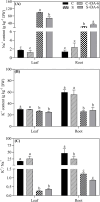
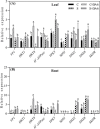
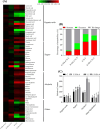
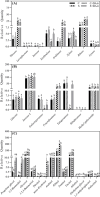
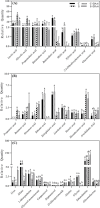

Similar articles
-
Diethyl aminoethyl hexanoate reprogramed accumulations of organic metabolites associated with water balance and metabolic homeostasis in white clover under drought stress.Front Plant Sci. 2024 Oct 11;15:1430752. doi: 10.3389/fpls.2024.1430752. eCollection 2024. Front Plant Sci. 2024. PMID: 39464286 Free PMC article.
-
The γ-Aminobutyric Acid (GABA) Alleviates Salt Stress Damage during Seeds Germination of White Clover Associated with Na⁺/K⁺ Transportation, Dehydrins Accumulation, and Stress-Related Genes Expression in White Clover.Int J Mol Sci. 2018 Aug 25;19(9):2520. doi: 10.3390/ijms19092520. Int J Mol Sci. 2018. PMID: 30149642 Free PMC article.
-
Exogenous 2-(3,4-Dichlorophenoxy) triethylamine alleviates salinity stress in maize by enhancing photosynthetic capacity, improving water status and maintaining K+/Na+ homeostasis.BMC Plant Biol. 2020 Jul 23;20(1):348. doi: 10.1186/s12870-020-02550-w. BMC Plant Biol. 2020. PMID: 32703161 Free PMC article.
-
Synergistic effects of phytohormones and membrane transporters in plant salt stress mitigation.Plant Physiol Biochem. 2025 Apr;221:109685. doi: 10.1016/j.plaphy.2025.109685. Epub 2025 Feb 20. Plant Physiol Biochem. 2025. PMID: 40007372 Review.
-
Role of autophagy in plant growth and adaptation to salt stress.Planta. 2025 Jan 31;261(3):49. doi: 10.1007/s00425-025-04615-2. Planta. 2025. PMID: 39885016 Review.
References
-
- Bouaziz M, Hihi S, Chtourou MY, Osunmadewa B. Soil salinity detection in semi-arid region using spectral unmixing, remote sensing and ground truth measurements. J Geographic Inform Syst. 2020;12(4):372–86.
-
- FAO. The state of the world’s land and water resources for food and agriculture—systems at breaking point. Rome: 2022.
-
- Parihar P, Singh S, Singh R, Singh VP, Prasad SM. Effect of salinity stress on plants and its tolerance strategies: a review. Environ Sci Pollut Res. 2015;22:4056–75. - PubMed
MeSH terms
Substances
Grants and funding
LinkOut - more resources
Full Text Sources
Research Materials
Miscellaneous

